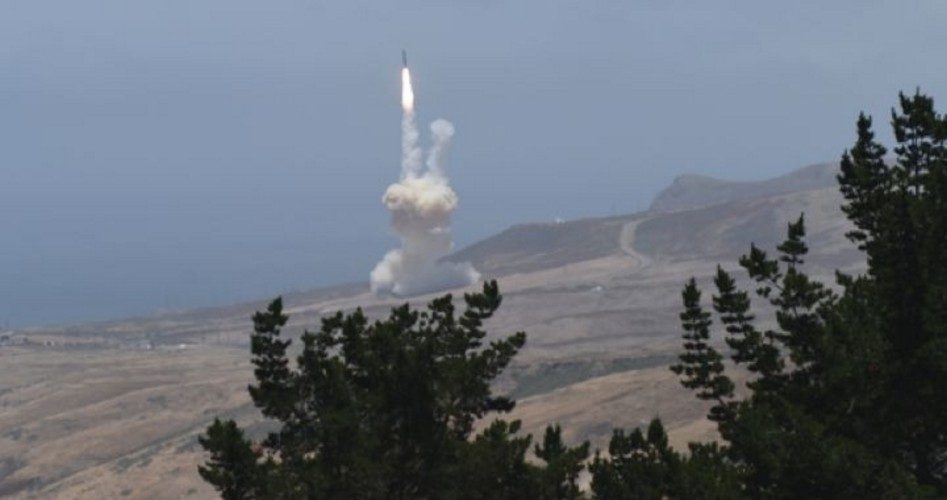
During a test conducted on May 30 by the U.S. Missile Defense Agency (MDA), in cooperation with the U.S. Air Force 30th Space Wing, a ground-based interceptor launched from Vandenberg Air Force Base in California intercepted an ICBM-class target launched from the Reagan Test Site on Kwajalein Atoll in the Republic of the Marshall Islands. Though U.S. officials did not specifically tie the test to North Korea’s recent missile tests — one occurred just the day before the U.S. test — the communist nation’s ongoing progress toward developing an ICBM makes the need for the United States to develop a defense system against such missiles obvious.
“The intercept of a complex, threat-representative ICBM target is an incredible accomplishment for the GMD system and a critical milestone for this program,” MDA Director Vice Admiral James Syring said in the statement quoted by Defense News. “This system is vitally important to the defense of our homeland, and this test demonstrates that we have a capable, credible deterrent against a very real threat.”
Jen Judson, the land warfare reporter at Defense News, noted in her May 30 article that the test was the first time the Ground-based Midcourse Defense (GMD) system was used against an ICBM-class target, although some previous tests have featured intermediate-range ballistic missile targets that have approached ICBM speeds. Judson quoted Tom Karako, a missile-defense analyst at the Center for Strategic and International Studies, who told Defense News: “This is an important day for homeland missile defense. Hit-to-kill has once again been validated, and this time against an ICBM. The Missile Defense Agency has been on a long road to improve the reliability and capability of the GBI fleet. Details are still coming in, but today’s test promises good things for the defense of the nation.”
Representatives of the Boeing Company, which is the prime contractor for the GMD system, called the intercept test an overwhelming success. Chris Raymond, vice president and general manager for Boeing’s Strategic Missile and Intelligence Systems unit, said during a May 31 media teleconference that the GMD system “is America’s only active defense against the threat of long-range ballistic missiles” and that “[the May 30] flight test was crucially important on a geopolitical scale.”
Space.com, which quoted the above statement, said that the Boeing representatives did not mention North Korea specifically, but Raymond referenced the importance of the GMD system when considering the “threats that we read about every day in the news.”
The Washington Post quoted a statement made in April by Navy Admiral Harry Harris, the chief of Pacific Command, who told the House Armed Services Committee that North Korea is “clearly in a position to threaten Hawaii today” with a ballistic missile attack and that the Pentagon should consider adding new ballistic missile interceptors and defensive radar there as a result.
“I believe that our ballistic missile architecture is sufficient to protect Hawaii today, but it can be overwhelmed,” Harris said to the committee. If the United States faced a wave of incoming ballistic missiles, he added, “someone would have to make a decision on which one to take out or not. So that’s a difficult decision.”
The urgency to develop a working anti-ballistic missile system has been increased by North Korea’s increasingly frequent missile tests — the latest occurring on May 29, when the communist state fired what was believed to be a Scud-class ballistic missile that flew about 280 miles before landing in Japan’s maritime economic zone. The nation has conducted dozens of missile tests and tested two nuclear bombs since the beginning of 2016 in defiance of UN Security Council resolutions.
We reported in our article on May 15 that on the previous day North Korea had fired a new ballistic missile that reached an altitude of 1,312 miles and covered a lateral distance of 489 miles. However, in an article posted on the 38 North website of the U.S. Korea Institute (USKI) department at the Johns Hopkins School of Advanced International Studies (SAIS), Dr. John Schilling, observed:
The missile would have flown a distance of some 4500 kilometers [2,796 miles] if launched on a maximum trajectory. It appears to have not only demonstrated an intermediate-range ballistic missile (IRBM) that might enable them to reliably strike the U.S. base at Guam, but more importantly, may represent a substantial advance to developing an intercontinental ballistic missile (ICBM).
Following the May 14 North Korean missile test, White House Press Secretary Sean Spicer issued a statement saying: “Let this latest provocation serve as a call for all nations to implement far stronger sanctions against North Korea.”
In response to Spicer’s statement, we responded in our May 22 article that “most Americans would probably be more reassured if our government would work at perfecting a better anti-ballistic missile (ABM) system that could intercept any North Korean missiles fired in our direction, instead of placing our hopes on sanctions.”
We continued by noting: “At present, the only system capable of intercepting North Korean missiles is the Ground-Based Midcourse Defense (GMD) located at interceptor sites at Fort Greely, Alaska and Vandenberg Air Force Base, California.”
In our May 29 article, written just after North Korea’s missile test that day, we cited a VOA report two days earlier about the U.S. military’s upcoming test of the GMD, which would “attempt to simulate a North Korean ICBM aimed at the United States.” We reported that, like VOA, we had also discussed the U.S. GMD system in our May 22 article about North Korea’s missile tests. Both our report and VOA’s had cited the exact same statistics about the reliability of the GMD system, noting that it had succeeded in only nine of 17 attempts against missiles without intercontinental range capability since 1999. We observed:
It is encouraging that VOA (which is a U.S. government-funded news source) cited the same statistics related to the GMD’s unreliability that we noted in our earlier report. If our government recognizes this fact and intends to develop a better anti-ICBM system, it will go a long way toward protecting Americans from North Korea’s threats.
We are even more encouraged by the successful May 30 test. Our government’s responsibility under Article IV, Section 4 of the Constitution includes protecting the states again invasion. Perhaps if we spent less money on unconstitutional operations such as defending the rest of the world against invasion, our military would have sufficient resources, such as the GMD system and a lean and ready-to-roll military, to protect our own nation.
Photo of interceptor launch: U.S. Department of Defense Missile Defense Agency
Related articles:
N. Korea Continues Missile Tests; U.S. Moves 3rd Carrier Strike Force to Western Pacific
North Korea Tests Another Missile, Says They Are Ready to Deploy
North Korea Tests Ballistic Missile Capable of Reaching U.S. Base on Guam
North Korea Threatens U.S. With “All Out War” and “Weekly Missile Tests”
North Korea’s Letter to Congress Says Pyongyang to Speed Up Nuke Program in Response to Sanctions
As N. Korea Celebrates Anniversary of Military, S. Korea Is on Alert
North Korea Threatens to Attack U.S. Carrier Group; Detains U.S. Citizen
Russia Says Troop Movement Near North Korean Border Was Scheduled
North Korea Warns of Nuclear Retaliation at Any Sign of U.S. “Aggression”
North Korea Admits Missile Launches Were Test of Possible Strike Against U.S.Bases in Japan
North Korea Missile Test Draws Reactions From Trump, Abe, and UN
North Korea Claims to Test H-Bomb
North Korea Postures With Nuclear Warning, Movement of Missiles
North Korea Attacks South Korea
North Korea Prepares to Launch Missile
Lawmakers Blast UN for Handing U.S. Technology to North Korea, Iran


